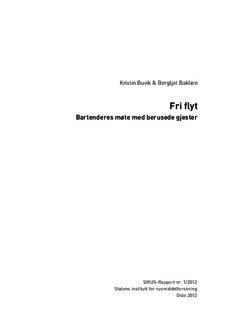| dc.description.abstract | Denne rapporten presenterer resultater fra en kartlegging av overskjenking på utesteder i utvalgte deler av Oslo sentrum. Den viktigste datakilden er testkjøp, som innebærer at skuespillere spiller beruset mens de bestiller øl på serveringssteder. Hensikten er å skape en situasjon som etter alkoholloven skal føre til serveringsnekt
Til sammen er det utført 89 testkjøp fordelt på 39 ulike serveringssteder i to områder i Oslo sentrum. Det var langt mellom serveringsstedene som nektet en gjest som viste flere tegn på åpenbar påvirkning. 83 av kjøpsforsøkene (93 %) resulterte i at testkjøperen fikk servering – det vil si at bare seks kjøpsforsøk (7 %) endte med serveringsnekt.
Det kan være flere forklaringer på den høye andelen servering. Kanskje mangler noen bartendere tilstrekkelig kunnskap om alkoholloven og om hvordan de skal håndtere en beruset gjest. Arbeidsforholdene er ikke alltid tilrettelagt for å sikre bartendere gode vurderingsmuligheter, og i en stresset situasjon er det kanskje lettere å servere gjesten en øl enn å ta konfrontasjonen som eventuelt vil oppstå ved avvisning av gjesten. Iblant kan kanskje økonomiske motiver påvirke serveringsutfallet – en serveringsnekt kan føre til mindre inntjening og tap av tips.
Det kan også se ut som om det er en ansvarsfraskrivelse fra bartendere til ordensvakter, ved at ansvaret for kontroll av gjestenes beruselsesnivå tillegges vaktene. Det kan også være slik at motivasjonen for å følge alkoholloven er liten, ettersom det er små sjanser for å bli tatt. Forklaringen på den høye andelen overskjenking finner vi trolig først og fremst i drikkekulturen, der det eksisterer en kollektiv aksept av beruselse på utestedene. Så lenge gjester, bartendere og bevillingshavere, og kanskje også kontrollører og de som sanksjonerer, er preget av den samme aksepterende alkoholkulturen, vil det være vanskelig å få til en endring. | |
| dc.description.abstract | What happens when a customer who is drunk wants to order beer in a bar. Does
the bartender serve her or not? How do bartenders react to customers’ behaviour?
This report presents the results of an investigation of serving alcohol to inebriated
customers in places that serve alcohol in selected areas of the centre of Oslo. The
main source of data is from test buying, which involves actors pretending to be
drunk and ordering beer from the bar. The aim is to create a situation in which,
according to the Alcohol Act, the bartender should refuse to serve the customer.
After each attempt to buy alcohol, the test buyer fills out a form in which he or she
registers the result of the attempt to be served, and other information that may be
of importance: the level of music, the amount of lighting, the level of inebriation of
other customers, how crowded the place is, whether there was a queue at the door
and at the bar, whether the place had security guards, the general amount of order,
and the bartender’s gender and approximate age. Altogether, 89 test attempts to buy
alcohol were made in 39 places in two areas in the centre of Oslo. They were carried
out on two Fridays and two Saturdays at the end of October 2011 between 23:30
and 03:00.
In order to obtain more information about the interaction between the bartender
and the customer, the test buyers were interviewed after their attempts to buy
alcohol. In addition, the test buyers and the situations in the bars were observed.
There were few bars in which customers who showed most of the signs of obvious
inebriation were refused to be served. Again and again both the observers and the
test buyers were surprised that beer was placed on the counter. Eighty-three
attempts to buy alcohol (93 %) were successful, and only six attempts (7 %) were
refused. There were more refusals in the places that did not have security guards at
the door. Because the percentage of refusals was low, it was not possible to make
other reliable comparisons between the places in which the test buyers were served
and the places in which they were not served. Therefore it was not possible to
explain the result of the attempt to be served alcohol according to the variables that
were registered.
The high level of serving alcohol to inebriated customers that was observed is
surprising, seen in relation to the level of serving inebriated customers that is
identified in municipal controls places that serving alcohol. The municipality of Oslo carried out 5 402 controls in 2011, and serving inebriated customers was
reported in only two per cent of the controls.
Bartenders react in different ways when they encounter customers who are
obviously inebriated – if they react at all. The most common «reaction» was not to
react. The bartenders avoided eye contact, they did not speak to the customer, and
they used only a few seconds to serve the customer. However, in some cases it was
clear that the bartender was aware that the customer was inebriated. Six of these
cases resulted in refusal. In other cases, it seemed to be obvious that the bartender
had perceived that the customer was inebriated, but had still served the customer.
Some of the bartenders laughed about the inebriation of the customer while they
served them, others did not seem to care that the customer was inebriated even
although they had seen it. Other bartenders chose to ignore the customer by
turning away while they poured the beer. In eight cases, the bartender encouraged
the test buyers to buy alcohol before they had managed to place an order.
There can be several explanations for the high level of serving. Maybe some
bartenders lack adequate knowledge about the Alcohol Act and about how to deal
with inebriated customers. The working environment is not always organized to
make it easy for the bartender to assess the situation. | |
